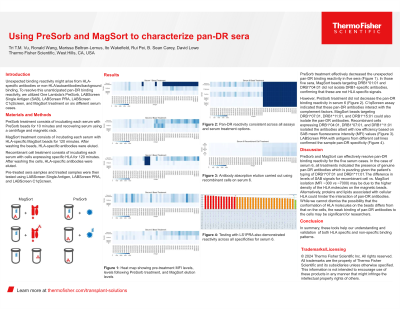Back

(P112) Using PreSorb and MagSort to characterize pan-DR sera.
Location: Platinum Ballroom


Tri Vu, PhD
Thermo Fisher
Poster Presenter(s)
Body: Unexpected binding reactivity might arise from HLA-specific antibodies or non-HLA/autoantibodies/background binding. To address this unanticipated pan-DR binding reactivity in sera, we utilized One Lambda’s PreSorb, Single Antigen, PRA, C1qScreen, and MagSort products. PreSorb treatment effectively decreased the unexpected binding reactivity in five sera. In those five sera, MagSort beads targeting DRB1*01:01 and DRB1*04:01 did not isolate DRB1-specific antibodies, indicating that these are background signals. However, PreSorb treatment increased binding reactivity in Serum-6. This serum was from a patient who has no history of transplant, transfusion, or pregnancy. LABScreen PRA with antigens from different cell lines confirmed LABScreen Single Antigen’s pan-DR results. The C1qScreen assay indicated that these pan-DR antibodies interact with complement factors. MagSort beads targeting DRB1*07:01, DRB1*11:01, and DRB1*15:01 were able to isolate the pan-DR antibodies.
Conclusion: PreSorb and MagSort can effectively resolve pan-DR binding reactivity. For the case of Serum-6, all treatment indicate that it contains genuine pan-DR antibodies. Previous studies had shown that infection and inflammation can alter monocyte HLA-DR expression. Patient with Serum-6 may have experienced repeated infections leading to these pan-DR antibodies. Further investigation to validate these antibodies using recombinant cells and EBV-immortalized human cells is underway.
Conclusion: PreSorb and MagSort can effectively resolve pan-DR binding reactivity. For the case of Serum-6, all treatment indicate that it contains genuine pan-DR antibodies. Previous studies had shown that infection and inflammation can alter monocyte HLA-DR expression. Patient with Serum-6 may have experienced repeated infections leading to these pan-DR antibodies. Further investigation to validate these antibodies using recombinant cells and EBV-immortalized human cells is underway.
